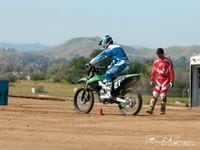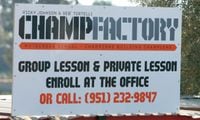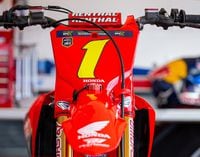I hate to start a story this way, but I have some bad news: You're not as fast as you think you are. No matter how talented, accomplished, brave, determined or just plain lucky you may be, there's almost no way that you can actually ride a motorcycle as quickly or as well as you think you can. How do I know this? Because I used to not be as fast as I thought I was. But thanks to a two-time World MX champion with a thorough knowledge of the complex processes involved in hauling the mail and a knack for conveying this information, I'm slowly learning that it's not at all about going as fast as you think you need to, it's about breaking things down and building them back up in the correct order. Confused? Keep reading, this will all make sense in a minute.Last issue, you read Pete Peterson's view on a one-day motocross school with Marty Smith. This, the sequel to that feature, is the recap of my experience on the next rung of the Moto School ladder, this time in a two-day intensive training camp with MX hero Sbastien Tortelli at his legendary racetrack in Perris, California. Now, I'd never received any sort of formal riding instruction before save for some much-welcomed tips from local pros and friends, and it didn't take long for my perceptions about moto education to be completed shattered by Tortelli's iron fist. Like most racers, I was under the impression that you show up at a riding school, fill your brain with little tips and tricks and then leave at the end of two days about four seconds faster than before. Not so! One of the first things that Tortelli stresses to his students is that the purpose of his riding school is not to make you faster immediately, but to give you the tools to make yourself faster over time. In fact, the champion warned in his still-present French accent that, "Eew may eeven become slover een zee next few veeks." Sacrebleu!This leads to Tortelli's next key point that all improvement comes from progressive steps. According to Sbastien, rarely will a rider stumble upon speed and chop three seconds off of his lap times. Rather, increased speed comes as a result of working on the most fundamental elements of riding and perfecting them in a specific order. And so, our day began with work on the basics, and the class of just over a dozen riders and I spent a good portion of the morning doing simple drills in the parking lot that, to be quite honest, felt awfully silly at first. That is, until I realized how much I needed to work on them. For example, Tortelli broke down the fine elements of braking and then stressed the specific succession in which they must be executed. You'd be surprised how easily the whole process can go wrong when you forget just one step! But when performed in the correct order, Tortelli's finer points of braking become one smooth motion, and doing this for the first time provides a quick taste of what it feels like to work with the motorcycle.For MX Schools Part 1, click here.
This Frenchman has eyes that don't miss a thing!
After nearly an hour of parking lot basics, we moved on to the perfectly groomed Perris Raceway track to put our newfound braking skills to use and begin learning how to apply this to the art of cornering. One thing that I should mention here is that our makeshift class consisted of riders of varying age and ability, yet Tortelli was able to speak to everyone right where they were at. This is accomplished through the use of a tape recorder (or as he calls it, his "reh-caw-der") that Sbastien makes notes with after each rider takes his turn doing a drill. These comments are then played back to the respective riders at the end of the drill, meaning that everyone-from the vet rider on CRF450R to the little guy on the KX65-gets to hear exactly what he or she personally needs to work on. Combined with Tortelli's organized and effective methods for executing drills, this system brings quite a bit of personal instruction to the student. It might not be as personal as a one-on-one clinic, but it's darn close. And don't you dare think that when speaking with students, Tortelli is just a former motocrosser who thinks everyone should ride just like him; he's actually one of the most intelligent, articulate (even with the accent) professors that our sport has ever seen. His way of conveying information to a rider-particularly a kid-is astounding to experience, and it was common to actually witness several of the other riders improve drastically after just a few thoughtful words from our teacher.Under the watchful eye of Tortelli and the ever-helpful advice emitted from his "reh-caw-der," our class moved methodically from one drill to the next, each of which built upon the skills practiced in the last area. By the end of the day, it was obvious that Tortelli's lesson plan isn't just a random arrangement of activities; rather, it's a well-planned series of skill-honing training evolutions that follow an almost scientific lesson plan. Another controlled element of the school is the fact that it takes place over two days, not just one. Tortelli explains that when you practice something during the day and then go to bed later that night, your mind is still processing everything new that you learned. He's found that students see much more improvement and gain a deeper understanding of the principles that he teaches when they simply sleep on it and then come back the next day.And so, our class-minus a handful of mini riders who had a big race to go to-arrived bright and early on day two. Tortelli spent much of the morning patiently hammering home what had been taught the first day, and we gradually learned to take these skills to new sections of the track. I can't give away any of Tortelli's secrets, but I will say that I was truly amazed at how smoothly everything comes together when you put all the pieces together in the correct sequence. At one point, Sbastien waved me over in the middle of a corner drill after I'd been relentlessly pounding one single rut for the better part of an hour. "Eew just deed zat perfectly," he reported. "I have nah-zing to add." Success! While not at all focusing on going faster-just doing it right-I'd effectively touched on what happens when it all works the way it is supposed to. Needless to say, my speed through the corner improved drastically, and I'd be lying if I said my confidence didn't as well.




/cloudfront-us-east-1.images.arcpublishing.com/octane/OFSXJJ5PZFEZ5D5ZPMCFVHJUMA.jpg)
/cloudfront-us-east-1.images.arcpublishing.com/octane/N2JLNLG44VEKBMEPORRDTMX5A4.jpg)
/cloudfront-us-east-1.images.arcpublishing.com/octane/EOERU244ONEWVKQ7C24OHMRVWY.jpg)
/cloudfront-us-east-1.images.arcpublishing.com/octane/JF4T3ULTGNHTVEKSTNKLJ2IGKY.jpg)

/cloudfront-us-east-1.images.arcpublishing.com/octane/FAOZEEEXFVA3ZK2PYMY3DHI2EQ.jpg)
/cloudfront-us-east-1.images.arcpublishing.com/octane/WCAUGYKA5FDZTB64FM36LJFMMM.jpg)
/cloudfront-us-east-1.images.arcpublishing.com/octane/EIDVOIN5IJDMRIVS2VNTOOBVSA.jpg)
/cloudfront-us-east-1.images.arcpublishing.com/octane/5BSWCTPONFB3DJFRPJ34STZMR4.jpg)
/cloudfront-us-east-1.images.arcpublishing.com/octane/KSERUHQUTNHLBCWKXS2R3TYZHI.jpg)
/cloudfront-us-east-1.images.arcpublishing.com/octane/GGOH2AQRSVHY5C5JLNEVYLB5SU.jpg)
/cloudfront-us-east-1.images.arcpublishing.com/octane/TJJEHV3ATZFFXHUYZABHXKE2DI.jpg)
/cloudfront-us-east-1.images.arcpublishing.com/octane/M7L5LNQ5JZENHNBTCHEIKZKD24.jpg)
/cloudfront-us-east-1.images.arcpublishing.com/octane/WIC4RXQ36BAXNIW6U4UJ3XDLKI.jpg)
/cloudfront-us-east-1.images.arcpublishing.com/octane/G64JLSXQBJFMVPTETPM4H353EU.jpg)
/cloudfront-us-east-1.images.arcpublishing.com/octane/ZBMLCCOSNJBIVAEC2OU6YSONKY.jpg)
/cloudfront-us-east-1.images.arcpublishing.com/octane/U7PDRXGEI5DCFJGSVGNLAHGIMA.jpg)
/cloudfront-us-east-1.images.arcpublishing.com/octane/S553MV5QAJFOHGOKYO7TJ6NGYA.jpg)
/cloudfront-us-east-1.images.arcpublishing.com/octane/62WLA7IMLVF2LIPTA4DGILHZIM.jpg)
/cloudfront-us-east-1.images.arcpublishing.com/octane/BW6RDLNDENAVFHMPINCIIY3XCI.jpg)
/cloudfront-us-east-1.images.arcpublishing.com/octane/FEROGJTVONBBZKEUH46OD6R2VY.jpg)
/cloudfront-us-east-1.images.arcpublishing.com/octane/IFBSQJ2HCFG5JKH4GM3NB5LC3M.jpg)
/cloudfront-us-east-1.images.arcpublishing.com/octane/GPNWD73XDJDG7LMXDVFDZ7CL2I.jpg)
/cloudfront-us-east-1.images.arcpublishing.com/octane/BDI3FSQXIFAYHNC62TCPI3DV7E.jpg)